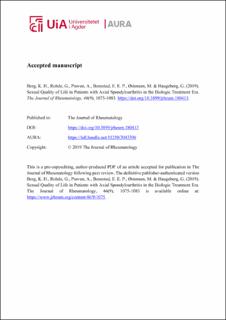| dc.contributor.author | Berg, Kari Hansen | |
| dc.contributor.author | Rohde, Gudrun E. | |
| dc.contributor.author | Prøven, Anne | |
| dc.contributor.author | Benestad, Esben Esther Pirelli | |
| dc.contributor.author | Østensen, Monika Elisabeth | |
| dc.contributor.author | Haugeberg, Glenn | |
| dc.date.accessioned | 2023-01-13T13:03:01Z | |
| dc.date.available | 2023-01-13T13:03:01Z | |
| dc.date.created | 2019-10-14T11:22:23Z | |
| dc.date.issued | 2019 | |
| dc.identifier.citation | Berg, K. H., Rohde, G., Prøven, A., Benestad, E. E. P., Østensen, M. & Haugeberg, G. (2019). Sexual Quality of Life in Patients with Axial Spondyloarthritis in the Biologic Treatment Era. The Journal of Rheumatology, 46(9), 1075-1083. | en_US |
| dc.identifier.issn | 1499-2752 | |
| dc.identifier.uri | https://hdl.handle.net/11250/3043396 | |
| dc.description | Author's accepted manuscript. | en_US |
| dc.description | This is a pre-copyediting, author-produced PDF of an article accepted for publication in The Journal of Rheumatology following peer review. The definitive publisher-authenticated version Berg, K. H., Rohde, G., Prøven, A., Benestad, E. E. P., Østensen, M. & Haugeberg, G. (2019). Sexual Quality of Life in Patients with Axial Spondyloarthritis in the Biologic Treatment Era. The Journal of Rheumatology, 46(9), 1075-1083 is available online at: https://www.jrheum.org/content/46/9/1075. | |
| dc.description.abstract | Objective. To examine the relationship between demographics, disease-related variables, treatment, and sexual quality of life (SQOL) in men and women with axial spondyloarthritis (axSpA).
Methods. AxSpA patients were consecutively recruited from 2 rheumatology outpatient clinics in southern Norway. A broad spectrum of demographics, disease, treatment, and QOL data were systematically collected. SQOL was assessed using the SQOL-Female (SQOL-F) questionnaire (score range 18–108). Appropriate statistical tests were applied for group comparison, and the association between independent variables and SQOL-F was examined using multiple linear regression analysis.
Results. A total of 360 (240 men, 120 women) axSpA patients with mean age 45.5 years and disease duration 13.9 years were included. Seventy-eight percent were married/cohabiting, 26.7% were current smokers, 71.0% were employed, 86.0% performed > 1-h exercise per week, and 88.0% were HLA-B27–positive. Mean (SD) values for disease measures were C-reactive protein (CRP) 8.5 (12.1) mg/l, Bath Ankylosing Spondylitis Disease Activity Index 3.1 (2.1), Bath Ankylosing Spondylitis Global Score (BAS-G) 3.8 (2.5), Bath Ankylosing Spondylitis Functional Index 2.7 (2.2), and Health Assessment Questionnaire 0.6 (0.5). The proportion of patients using nonsteroidal antiinflammatory drugs was 44.0%, synthetic disease-modifying antirheumatic drugs (DMARD) 5.0%, and biologic DMARD 24.0%. Mean (SD) total sum score for SQOL was 76.6 (11.3). In multivariate analysis, female sex, increased body mass index, measures reflecting disease activity (BAS-G and CRP), and current biologic treatment were independently associated with a lower SQOL.
Conclusion. Our data suggest that inflammation in patients with axSpA even in the biologic treatment era reduces SQOL. | en_US |
| dc.language.iso | eng | en_US |
| dc.publisher | The Journal of Rheumatology Publishing | en_US |
| dc.relation.uri | http://www.jrheum.org/content/46/9/1075 | |
| dc.title | Sexual Quality of Life in Patients with Axial Spondyloarthritis in the Biologic Treatment Era | en_US |
| dc.type | Journal article | en_US |
| dc.type | Peer reviewed | en_US |
| dc.description.version | acceptedVersion | en_US |
| dc.rights.holder | © 2019 The Journal of Rheumatology | en_US |
| dc.subject.nsi | VDP::Medisinske Fag: 700::Klinisk medisinske fag: 750::Reumatologi: 759 | en_US |
| dc.source.pagenumber | 1075-1083 | en_US |
| dc.source.volume | 46 | en_US |
| dc.source.journal | Journal of Rheumatology | en_US |
| dc.source.issue | 9 | en_US |
| dc.identifier.doi | 10.3899/jrheum.180413 | |
| dc.identifier.cristin | 1736846 | |
| cristin.qualitycode | 1 | |
